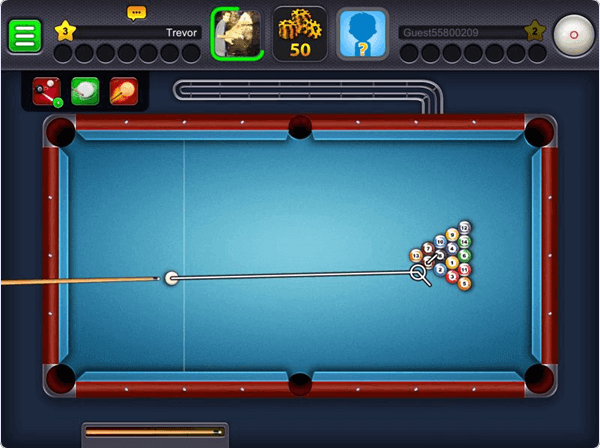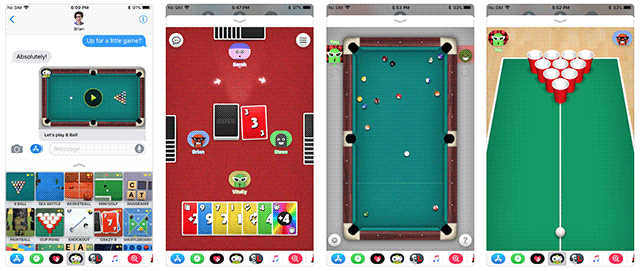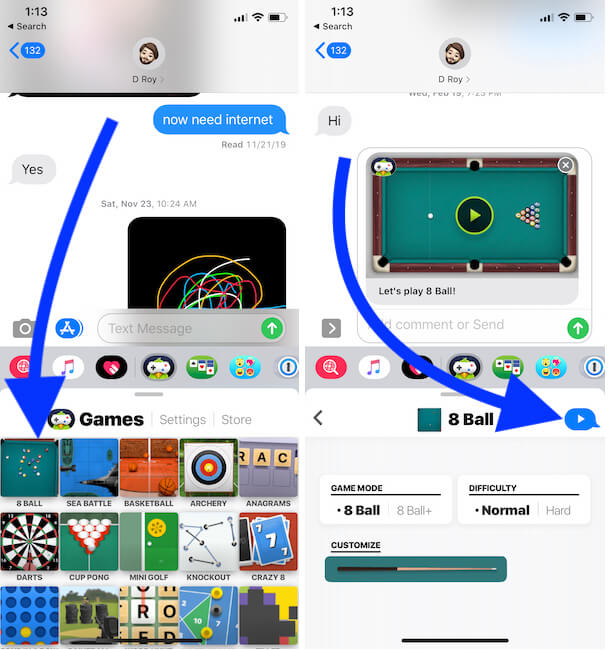
The main rule of this game is the player must pocket 8 balls to win the game. How to Play Pool on Game Pigeon: How to Install. Launch the iMessage app on “device.” Search for “Game pigeon” and download the app from the “app store.” Please open it and browse for the 8-ball pools game. Select create the game. Now start playing with. Someone teach me how to play 8 ball pool. Posted by 1 day ago. Got wins in all but 4 games dm to play. No money for fun only. Posted by 2 days ago. IMessages games no money for fun.
Eight-ball (also spelled 8-ball or eightball, and sometimes called solids and stripes, spots and stripes[1] or highs and lows) is a pool billiards played on a billiard table with six pockets, cue sticks, and sixteen billiard balls: a cue ball and fifteen object balls. The object balls include seven solid-colored balls numbered 1 through 7, seven striped balls numbered 9 through 15, and the black 8 ball. After the balls are scattered with a break shot, a player is assigned either the group of solid or striped balls once they have legally pocketed a ball from that group. The object of the game is to legally pocket the 8 ball in a 'called' pocket, which can only be done after all of the balls from a player's assigned group have been cleared from the table.
The game is the most frequently played discipline of pool, and is often thought of as synonymous with 'pool'. The game has numerous variations, mostly regional. It is the second most played professional pool game, after nine-ball, and for the last several decades ahead of straight pool.[citation needed]
History[edit]
The game of eight-ball arose around 1900 in the United States as a development of pyramid pool, which allows any eight of the fifteen object balls to be pocketed to win. The game arose from two changes made, namely that the 8 ball must be pocketed last to win, and that each player may only pocket half of the other object balls. By 1925 the game was popular enough for the Brunswick-Balke-Collender Company to introduce purpose-made ball sets with seven red, seven yellow, one black ball, and the cue ball, which allowed spectators to more easily see which suit each ball belonged to. (Such colors became standard in the later British-originating variant, blackball.) The rules, as officially codified in the Billiard Congress of America's rule book, were periodically revised in the years following.[2]:24, 89–90[3][4][5]
Standardized rules of play[edit]
American-style eight-ball rules are played around the world by professionals, and in many amateur leagues. Nevertheless, the rules for eight-ball may be the most inconsistent of any billiard game as there are several competing sets of 'official' rules.
The non-profit World Pool-Billiard Association (WPA), which has continental and national affiliates around the world (some of which long pre-date the WPA, such as the Billiard Congress of America) promulgates standardized rules as Pool Billiards – The Rules of Play.[6] These are used for amateur and professional play.
Meanwhile, many amateur leagues – such as the American Poolplayers Association (APA) and its affiliate the Canadian Poolplayers Association (CPA), the Valley National Eight-ball Association (VNEA) and the BCA Pool League (BCAPL) – use their own rulesets which have slight differences from WPA rules and from each other. Millions of individuals play informally, using informal 'house rules' which vary not only from area to area but even from venue to venue.
Equipment[edit]
The regulation size of the table's playing surface is 9 by 4.5 ft (2.7 by 1.4 m), though exact dimensions may vary slightly by manufacturer. Some leagues and tournaments using the World Standardized Rules may allow smaller sizes, down to 7 by 3.5 ft (2.1 by 1.1 m). Early 20th-century 10 by 5 ft (3.0 by 1.5 m) models are occasionally also still used. WPA professional competition generally employs regulation tables, while the amateur league championships of various leagues, including ACS, BCAPL, VNEA, and APA, use the seven-foot tables in order to fit more of them into the hosting venue.
There are seven solid-colored balls numbered 1 through 7, seven striped balls numbered 9 through 15, an 8 ball, and a cue ball. The balls are usually colored as follows:
- 1 and 9: yellow
- 2 and 10: blue
- 3 and 11: red
- 4 and 12: purple
- 5 and 13: orange
- 6 and 14: green
- 7 and 15: maroon
- 8: black
- Cue: white
Special sets designed to be more easily discernible on television substitute pink for the dark purple of the 4 and 12 and light tan for the darker maroon of the 7 and 15 balls, and these alternative-color sets are now also available to consumers.
Setup[edit]
To start the game, the object balls are placed in a triangular rack. The base of the rack is parallel to the end rail (the short end of the pool table) and positioned so the apex ball of the rack is located on the foot spot. The balls in the rack are ideally placed so that they are all in contact with one another; this is accomplished by pressing the balls together toward the apex ball. The order of the balls should be random, with the exceptions of the 8 ball, which must be placed in the center of the rack (i.e., the middle of the third row), and the two back corner balls, one of which must be a stripe and the other a solid. The cue ball is placed anywhere the breaker desires behind the head string.
Break[edit]
One person is chosen by some predetermined method (e.g., coin toss, lag, or win or loss of previous game or match) to shoot first, using the cue ball to break the object-ball rack apart. In most leagues it is the breaker's opponent who racks the balls, but in some, players break their own racks. If the breaker fails to make a successful break—usually defined as at least four balls hitting cushions or an object ball being pocketed—then the opponent can opt either to play from the current position or to call for a re-rack and either re-break or have the original breaker repeat the break.
If the 8 ball is pocketed on the break, then the breaker can choose either to re-spot the 8 ball and play from the current position or to re-rack and re-break; but if the cue ball is also pocketed on the break then the opponent is the one who has the choice: either to re-spot the 8 ball and shoot with ball-in-hand behind the head string, accepting the current position, or to re-break or have the breaker re-break.
Turn-taking[edit]
A player (or team) continues to shoot until committing a foul or failing to legally pocket an object ball (whether intentionally or not); thereupon it is the turn of the opposing players. Play alternates in this manner for the remainder of the game. Following a foul, the incoming player has ball-in-hand anywhere on the table, unless the foul occurred on the break shot, as noted previously.[6]
Most 8 Ball Game Pigeon Wins Ever
Selection of the target group[edit]
The table is 'open' at the start of the game, meaning that either player may shoot at any ball. It remains open until one player legally pockets one or more object balls (excluding the 8) after the break. That player is assigned the group, or suit, of the pocketed ball – 1–7 (solids), or 9–15 (stripes) – and the other suit is assigned to the opponent. Balls pocketed on the break, or as the result of a foul while the table is still open, are not used to assign the suits. If a player pockets balls from both suits on an open table, they may claim either suit as their own.
Once the suits are assigned, they remain fixed throughout the game. If any balls from a player's suit are on the table, the player must hit one of them first on every shot; otherwise a foul is called and the turn ends. After all balls from the suit have been pocketed, the player's target becomes the 8 for the remainder of the game.
Pocketing the 8 ball[edit]
Once all of a player's (or team's) group of object balls are pocketed, the player attempts to sink the 8 ball. In order to win the game the player first designates which pocket the 8 ball will be pocketed into and then successfully pockets the 8 ball into that pocket. If the player knocks the 8 ball off the table then the player loses the game. If the player pockets the 8 ball and commits a foul or pockets it into another pocket than the one designated, then the player loses the game. Otherwise (i.e., if the 8 ball is neither pocketed nor knocked off the table) the shooter's turn is simply over, even if a foul occurs. In short, a world-standardized rules game of eight-ball, like a game of nine-ball, is not over until the 'money ball' is no longer on the table. The rule has been increasingly adopted by amateur leagues.
Winning[edit]
A player wins the game if that player legally pockets the 8 ball into a designated pocket after all of their object balls have been pocketed. They may also win if the opposing player illegally pockets the 8 ball or knocks the 8 ball off the table. Because of this, it is possible for a game to end with only one of the players having shot, which is known as 'running the table'.

Fouls[edit]
Fouls in eight-ball are:


- The shooter fails to strike one of their own object balls (or the 8 ball when it is the legal ball) with the cue ball, before other balls are contacted by the cue ball. This excludes 'split' shots, where the cue ball strikes one of the shooter's and one of the opponent's object balls simultaneously.
- No ball comes into contact with a cushion or is pocketed, after a legal cue ball contact with the (first) object ball.
- If an attempt is made to pocket a ball, and the ball hits the pocket, bounces out and lands on the ground, the ball is placed in the pocket and the game continues.
- The shooter does not have at least one foot on the floor (this requirement may be waived if the shooter has a relevant disability, or the venue has not provided a mechanical bridge).
- The cue ball is pocketed.
- The cue ball is shot before all balls have come to a complete stop from the previous shot.
- The cue ball does not strike any ball.
- The cue ball is struck more than once during a shot
- The cue ball is jumped with an illegal jump shot that scoops under the cue ball.
- The cue ball is clearly pushed, with the cue tip remaining in contact with it more than momentarily.
- The shooter touches the cue ball with something other than the tip of the cue.
- The shooter touches any ball with their body, clothing, or equipment, other than as necessary to move the cue ball when the player has ball-in-hand.
- The shooter knocks a ball off the table.
- The shooter shoots out-of-turn.
- The shooter shoots the black 8 ball without designating the pocket to opposite team members or the match referee in advance.
- The shooter deliberately pockets the opponent's balls while shooting the 8 ball.
- On the break shot, no balls are pocketed and fewer than four balls reach the cushions, in which case the incoming player can demand a re-rack and take the break or force the original breaker to re-break, or may take ball-in-hand behind the head string and shoot the balls as they lie.
Variants[edit]
Blackball[edit]
The British version of eight-ball, known internationally as blackball, has evolved into a separate game, retaining significant elements of earlier pub versions of the game, with additional influences from English billiards and snooker. It is popular in amateur competition in the UK, Ireland, Australia and some other countries.
The game uses unnumbered, solid-colored object balls, typically red and yellow, with one black 8 ball. They are usually 2 inches (51 mm) or 2+1⁄16 inches (52 mm) in diameter, the latter being the same size as the balls used in snooker and English billiards. Tables for blackball pool are 6-to-7-foot (1.8 to 2.1 m) long, and feature pockets with rounded cushion openings, like snooker tables.
The rules of blackball differ from standard eight-ball in numerous ways, including the handling of fouls, which may give the opponent two shots, racking (the 8 ball, not the apex ball, goes on the spot), selection of which group of balls will be shot by which player, handling of frozen balls and snookers, and many other details.
How To Win In Game Pigeon 8 Ball
Internationally, the World Pool-Billiard Association and the World Eightball Pool Federation both publish rules and promote events. The two rule sets differ in some details regarding the penalties for fouls.
Chinese eight-ball[edit]
Eight ball as played in major Chinese tournaments such as the Chinese Eight-ball World Championship. The rules are essentially the same as standard WPA rules, and the game is played with standard 2+1⁄4-inch solids-and-stripes balls, but the tables are constructed similarly to 9-foot snooker tables, with rounded pocket opening, napped cloth, and flat-faced rail cushions, which results in some differences in gameplay approach. The variant arose in the mid 1980s and 1990s as eight-ball gained popularity in China, where snooker was the most popular cue sport at the time. With standard American-style pool tables rare, Chinese players made do with playing eight-ball on small snooker tables. It has since become the most popular cue sport in China, and the major tournaments have some of the largest prize money in pool.
Eight-ball rotation[edit]
The hybrid game eight-ball rotation is a combination of eight-ball and rotation, in which the players must pocket their balls (other than the 8, which remains last) in numerical order. Specifically, the solids player starts by pocketing the 1 ball and ascends to the 7 ball, and the stripes player starts by pocketing the 15 ball and descends to the 9 ball.
Backwards eight-ball[edit]
A variant in which, instead of shooting the cue ball at an object ball to force the object ball into a pocket, the player strikes the object ball with their cue so it caroms off the cue ball and into a pocket, in a fashion similar to Russian pyramid. Also known as 'reverse eight-ball'.
See also[edit]
References[edit]
- ^'Scottish Pool Association'. Archived from the original on 13 April 2014.
- ^Shamos, Mike (1999). The New Illustrated Encyclopedia of Billiards. New York: Lyons Press. ISBN1-55821-797-5.
- ^Jewett, Bob (February 2002). '8-Ball Rules: The Many Different Versions of One of Today's Most Common Games'. Billiards Digest: 22–23.
- ^Hickok, Ralph (2001). 'Sports History: Pocket Billiards'. Archived from the original on 5 December 2006. Retrieved 13 December 2006.
- ^Shamos, Mike (1995–2005). 'A Brief History of the Noble Game of Billiards'. Billiard Congress America. Archived from the original on 27 January 2007. Retrieved 13 December 2006.
- ^ abPool Billiards – The Rules of Play(PDF). World Pool-Billiard Association. 1 January 2008. Archived from the original(PDF) on 19 November 2011. Retrieved 21 March 2012.
External links[edit]

GamePigeon is an interesting collection of games on iMessage. Sometimes the games become somehow tough and you definitely need some help. One of the most popular games that people really try hard to beat their friends at is 8-ball pool. You can easily become an expert on 8-ball pool through enough practice.
Alternatively, you can easily use 8-ball pool cheats to beat your friends on this iMessage game. Cheats will unlock levels and help you pass tough setups.
Here is how to play 8-ball pool on iMessage perfectly.
Read Also: Best games on GamePigeon
How to start 8-ball pool on GamePigeon
To start the game just open iMessage and on the apps find 8-ball Pool. Send it to the contact you want to play with and the game will initiate.
Your competitor must have installed the game before you can be able to play.
The rules of iMessage 8-ball pool are just the same rules of the contemporary 8 ball pool. You first arrange the balls and aim with a v-shaped indicator.
The white ball will hit the balls and the sequence follows only this time taking aim from the current position of the white ball.
Read Also:How to uninstall GamePigeon
Tips and tricks
- The first tip is to always aim for the second last ball on the last row of balls when opening play. Once you aim for the ball power up to full bar and release the shot. This way at least one ball will be pocketed and the rest well lined for easy pickings.
- You can navigate to the bottom part of the screen to find the game settings such as music, sound and images. Disable these settings to save battery and cellular data.
- You can use a ruler to find the perfect angle when playing. Angle the ruler to measure up how the ball will go and then aim for the holes correctly.
- Observe the aim circle before taking any shot. If the aim circle has lines on the middle do not take the shot but adjust the aim until it disappears.
There are not many 8-ball pool cheats but the above ones will surely give you an edge when playing. Combine the tips well to be able to get the results. In the event you do not have a ruler find any item with a straight edge to line up the shot.
Read Also:How to play GamePigeon games on Mac